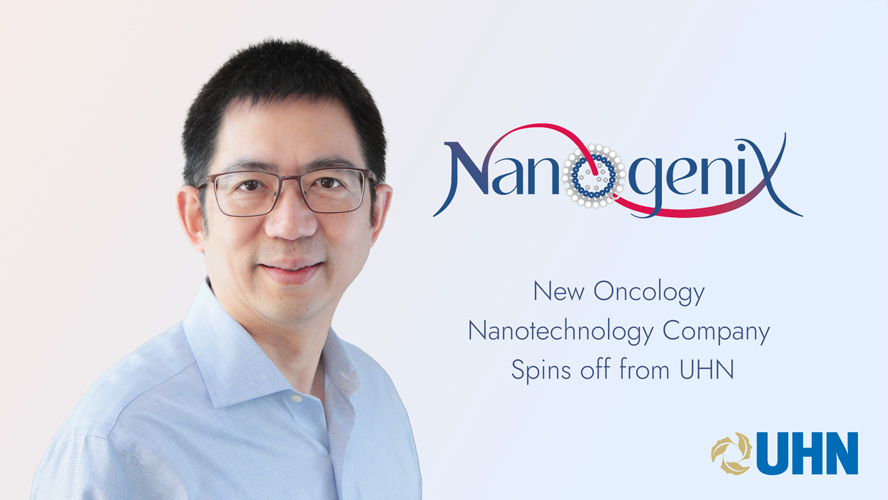
Nanogenix™, a UHN spinoff biotechnology company, was recently launched to test emerging photo-immune cancer treatments.
The company’s core technology is based on Dr. Gang Zheng’s decade of research on naturally occurring lipid-based nanoparticles called porphysomes. These small particles interact with light and oxygen and can be customized to carry out specific functions in the body.
The technology is highly versatile. Porphysomes can be used to directly target and kill cancer cells. They can also be used as part of imaging-guided interventions to track residual cancer cells—serving as a valuable accompaniment to cancer surgeries.
Since Dr. Zheng’s discovery of porphysomes in 2011, his team has made much progress towards commercializing it and translating the technology to the clinic.
In preclinical studies, the team has also demonstrated that porphysomes can be selectively targeted to cancer cells in experimental models of head and neck, pancreas, lung, brain, prostate and colorectal cancers. These studies also evaluated the safety of porphysomes, as well as the ability to scale up the manufacturing of clinical grade porphysomes. Combined, these efforts have set the stage for first-in-human clinical studies.
“It has been a long journey,” says Dr. Zheng. “Our progress would not have been possible without support from The Princess Margaret Cancer Foundation through the Innovation Acceleration Fund, as well as support from the Terry Fox Research Institute. We were also grateful for support from the Toronto Innovation Acceleration Partners program.”
Because light is required to activate the therapeutic effect of porphysomes, the treatment requires a medical lighting device. The team collaborates with PM Senior Scientist Dr. Brian Wilson, who is a world expert in laser biophysics and optical technologies for cancer detection and treatment. Dr. Wilson served as the project leader for the initial porphysome program funded by the Terry Fox Research Institute between 2014 and 2017. Another key collaborator is Michael Valic, the project manager for the porphysome project and a current PhD student in Dr. Zheng’s lab. He has played an instrumental role in driving the translation of the porphysome technology since 2017.
Given the multifaceted functions of porphysomes, spinning the technology towards the market was a challenge. To overcome these challenges, Commercialization at UHN recruited an Entrepreneur-in-Residence (EIR), as part of their venture creation process. This approach enables seasoned commercialization experts to work alongside scientific co-founders for the successful launch of a new venture. They take primary responsibility for building a business model, a go-to-market strategy and fundraising plan, with the option to transition into the company’s executive management upon incorporation.
Glenn Kutschera joined as the EIR for porphysome project and is now the CEO of Nanogenix. He served as the past president of a prominent U.S.-based photodynamic company. To Nanogenix, he brings years of market, regulatory, product launch and business development expertise. Glenn has long searched for a photo-immune technology that can address current limitations in the market space.
One limitation of photo-immune therapies is that patients become photosensitive after current treatments and must avoid light for up to five weeks. When Glenn contacted Dr. Zheng’s group, he asked the team to test whether porphysomes might have a shorter light sensitivity window. He also wondered about its efficacy compared to current therapies. The findings were encouraging. Glenn and the research team were elated to discover that porphysomes provide an improved therapeutic effect with a light sensitivity of only eight days in experimental models.
“We are very fortunate to have Glenn join to help launch the company,” says Dr. Zheng. “He has a very clear vision on how to position porphysomes in the marketplace and knows exactly what is needed to advance the project.”
Nanogenix is currently focused on treating pancreatic cancer and skin cancer—two cancers with a well-established patient population. Both of these cancers also lead to tumours that can be easily accessed by light. An important element of this experimental therapy is that it is nontoxic. The nanoparticles used are natural lipid-based particles. Apart from its localized light-activated properties, the therapy was also found to be able to upregulate immune response. The team was excited and will be exploring how the therapy can work synergistically with immunotherapies.
“We are very impressed with these preclinical results to date, and we look forward to our first clinical trial next year,” says Glenn Kutschera.
Click here to read the press release.
Listen to Dr. Zheng’s interview on the UHN podcast Behind the Breakthrough S3E6 where he talks about the potential impact of porphysome nanotechnology.

An illustration of a porphysome that was published in Chemical Society Reviews to highlight work from Dr. Zheng’s laboratory.




